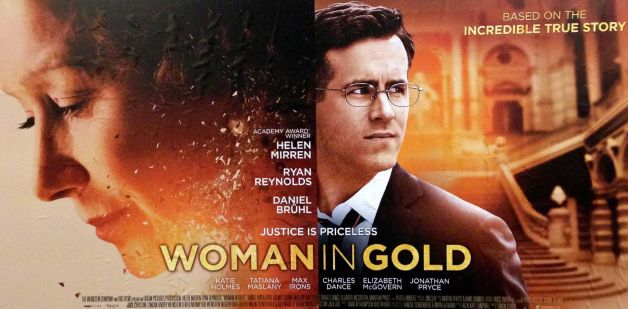By Kellen Quigley
Staff Writer
“Woman in Gold” is a motion picture worth a thousand screengrabs.
From director Simon Curtis, best known for his 2011 film “My Week with Marilyn,” comes the true story of an elderly Jewish woman, Maria Altman, her lawyer, Randol Schoenberg and their attempts to recover stolen artwork that once belonged to Altman’s family.
Six decades after World War II, Altman, played by Helen Mirren, returns to Vienna to reclaim family belongings that Nazis seized during the annexation of Austria. Chief among those items is the Gustav Klimt painting “The Lady in Gold,” a portrait of Altman’s aunt illegally given to the Austrian State Gallery after the war.
With the help of her ambitious young lawyer, played by Ryan Reynolds, Altman takes her fight from Austria all the way to the U.S. Supreme Court in order to receive the justice she believes her family deserves.
“Woman in Gold” is another British production released by The Weinstein Company in the United States. In recent years, the Weinsteins released “The King’s Speech” and “The Imitation Game,” proving traditional war dramas can still make money and satisfy critics. As with those movies, “Woman in Gold” is a solid production. However, because of the old-fashioned techniques with nothing new to offer, it is possible few will remember later this year.
The screenplay by Alexi Kaye Campbell kept the action moving by not including unneeded background. Beginning in 1907 with the painting’s creation and ending in 2006 with the final court cases, this movie tells the nearly 100-year history of one family in only one hour and 49 minutes. For a first attempt at writing by Campbell, an actor for over 20 years, he succeeds.
Courtroom movies often have dense, technical dialogue that may confuse audiences. However, the crucial court scenes here flowed like a chat between two friends instead of two lawyers. The dialogue is accessible and understandable.
Even with the solid script and easy flow, the actors themselves make the film. Although best known for her Oscar-winning performance as Queen Elizabeth II in “The Queen,” Mirren truly succeeds at portraying ordinary people doing extraordinary things. Here, Altman is doing what she believes is right for her family. Mirren brings that determination in the character out in subtle but powerful ways.
Ryan Reynolds’ best roles are regular, likeable leading men—just see his performances in “The Proposal” and “Definitely, Maybe.” Like Mirren’s Altman, he is someone ordinary who does something extraordinary. Reynolds’ dry humor made the character easy to like, especially when he had to do unlikeable lawyer things for the sake of the case. Reynolds’ combination of likeability and determined lawyer made the character memorable.
The legal battle is only about half of the movie. A good portion consists of flashbacks to Altman’s childhood in Austria and Altman as a young woman escaping Europe before the war begins.
Most impressive about these flashbacks is the cinematography. The use of 1920’s era two-color Technicolor has everything filtered through red and green, creating vintage-looking shots.
It is common to see poor Jewish families oppressed in movies about World War II, but something rarely seen is wealthy Jewish families dealing with the Nazis. Seeing a wealthy Jewish family with such prominence in the community financially and politically abused by the Nazis is interesting. It shows that the Nazis could do as much damage mentally to the rich as physically to the poor.
Even though “Woman in Gold” uses old-fashioned techniques with nothing spectacular or new, it does have a great script, great performances and a distinct style that made it a solid production.
quiglekm11@bonaventure.edu









